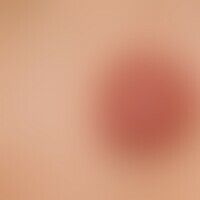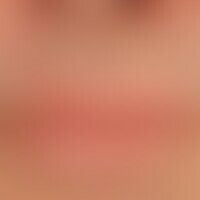Image diagnoses for "red"
877 results with 4458 images
Results forred

Gaiter ulcer I83.0
gaiter ulcer. large, yellowish ulcer in the calf area in a 61-year-old female patient with lymphedema persisting for 25 years. after skin transplantation approx. 1.5 years ago, since then severe oozing and pain. distinct reddening of the periulcerous area. massive pain in the ulcerous area, indentable oedema.

Primary cutaneous B-cell lymphomas C82- C83
Lymphoma, cutaneous B-cell lymphoma. Chronically active, continuously increasing clinical picture, existing for 6 months. red, blurred, solid, not painful, non-scaling nodular agglomerate consisting of several individual nodes, located on the lateral thorax, with a bumpy surface.

Tinea pedis (overview) B35.30
Tinea pedum. general view: Persistent redness and scaling, partly with severe itching, in the area of the left foot in a 30-year-old female patient, which has not healed for about 13 years. sharply defined, marginal scaling erythema, pustular formation.
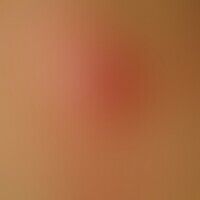
Myiasis (overview) B87.9
Furunculoid myiasisMyiasis: After a stay in the tropics the 25-year-old patient showed a furunculoid nodule with central porus on the left thigh which was only slightly (!) painful.

Perioral dermatitis L71.0
Perioral dermatitis: dermatitis that has persisted for months and is resistant to therapy. Intermittent local treatment with corticostroidexterna. No known rosacea.
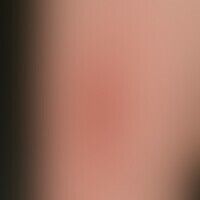
Lichen simplex chronicus L28.0
Lichen simplex chronicus. approx. 3 x 5 cm large, itchy plaque with rough surface on the ventro-medial right lower leg of a 14-year-old female patient. In the surrounding area distinct scratch artefacts and also follicularly bound papules. In case of stress worsening; during stays at sea improvement of the findings.
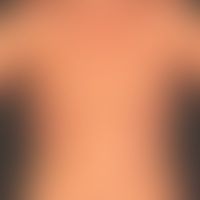
Psoriasis erythema anulare centrifugum-like L40.8
Psoriasis Erythema anulare centrifugum-like: relapsing-active plaque psoriasis with disseminated, anular lesions
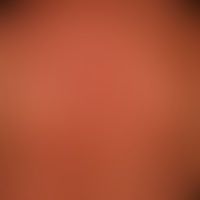
Lupus erythematosus systemic M32.9
Systemic lupus erythematosus: acute maculopapular exanthema, accompanied by recurrent fever attacks, fatigue and tiredness, arthralgia, inflammation parameters +, ANA high titer positive, rheumatoid factor +, DNA-AK+.

Varicella B01.9
Varicella: generalized exanthema (aspects of erythema multiforme) with coexistence of larger and smaller papules, vesicles, plaques.

Dermatitis herpetiformis L13.0
Dermatitis herpetiformis. 3 months recurrent, disseminated, papules and vesicles on distinct erythema in a 59-year-old patient. in several efflorescences a blown off halo (bright rim) is visible. at the right border of the picture several fresh, barely 1 mm large reddened papules. the symptoms are described as unpleasantly stinging. no gastrointestinal symptoms.

Dyshidrotic dermatitis L30.8
Cheiropompholyx: Large vesicular dyshidrotic eczema (Cheiropompholyx) occurring within 2 days in a 42-year-old patient with recurrent attacks of mild vesicular dyshidrotic eczema. An atopic diathesis is known.

Lymphomatoids papulose C86.6
Lymphomatoid papulosis: intermittent, painless, papules and nodules with central necrosis and crust formation (nodules above).

Leg ulcer L97.x0
Ulcer cruris: Painful ulcer extending to the muscle fascia, with sharp edges and painful ulcer in necrobiosis lipoidica; bizarre vascular ectasia due to the atrophying underlying disease.

Schnitzler syndrome L53.86
Schnitzler syndrome: considerable feeling of illness with recurrent fever attacks, itchy urticarial (here rather discreetly developed) exanthema (exanthema attacks go parallel with the periodic fever); furthermore exhaustion and tiredness.

Purpura pigmentosa progressive L81.7
Purpura pigmentosa progressiva. incident light microscopy, blurred, yellow-brownish spots (star), in addition to punctiform, fresh bleeding (horizontal arrow) also older brown-reddish spots already in decomposition (vertical arrow). line pattern: traced skin line pattern of the skin of the lower leg

Contact dermatitis allergic L23.0
Contact dermatitis allergic: multiple, acute, continuously progressive for 4 weeks, large, isolated and confluent, blurred (scattered edges), severely itching, red, rough, scaly, weeping plaques. polymorphism by papules, erosions, vesicles.
